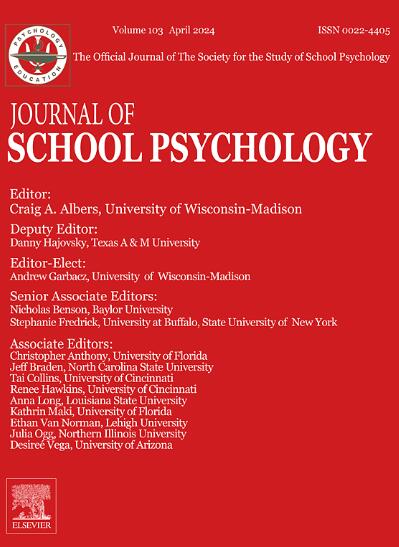检验SAEBRS评分、分类和潜在特征的稳定性
IF 4.1
1区 心理学
Q1 PSYCHOLOGY, SOCIAL
引用次数: 0
摘要
我们调查了社会、学术和情感行为风险筛查(SAEBRS)的稳定性,使用了K-5学生(N = 1253)在一个学年的三个普遍筛查场合(即秋季、冬季和春季)的教师报告评分的自然样本。我们分析了SAEBRS原始评分和从这些评分得出的分类在筛查场合之间的稳定性。结果表明,SAEBRS总量表和子量表的原始评分稳定性较强,分类稳定性中至强,情绪行为子量表的相对稳定性最差。我们还探讨了SAEBRS子量表分数所显示的潜在特征,这些特征在不同场合下的成员稳定性,以及学生社会人口学特征在预测这些特征中的成员资格方面的作用。研究结果表明,确定了两种一般风险概况(即有风险和无风险),并且这些概况的成员在筛查场合具有很强的稳定性。此外,我们发现学生的年级水平、性别、种族/民族、特殊教育和免费/减价午餐状况显著地预测了风险概况的成员资格。总体而言,结果表明SAEBRS的原始分数、分类和潜在特征在一个学年的三次筛查中都表现出良好的稳定性。我们讨论了这些发现对在基础环境中使用SAEBRS进行普遍筛查的意义,并强调了未来研究的关键方向。本文章由计算机程序翻译,如有差异,请以英文原文为准。
Examining the stability of SAEBRS scores, classifications, and latent profiles
We investigated the stability of the Social, Academic, and Emotional Behavior Risk Screener (SAEBRS) using a naturalistic sample of teacher-report ratings for K–5 students (N = 1253) across three universal screening occasions (i.e., fall, winter, and spring) within one school year. We analyzed the stability of SAEBRS raw scores and classifications derived from these scores between screening occasions. Results showed strong raw score stability and moderate-to-strong classification stability for the SAEBRS total scale and subscales, with the Emotional Behavior subscale demonstrating the weakest relative stability. We also explored latent profiles indicated by SAEBRS subscale scores, the stability of membership in these profiles across occasions, and the role of student sociodemographic characteristics in predicting membership within these profiles. Findings indicated that two general risk profiles (i.e., at-risk and not at-risk) were identified and that membership in these profiles had strong stability across screening occasions. Moreover, we found that students' grade level, sex, race/ethnicity, special education, and free/reduced-price lunch status significantly predicted membership in the at-risk profile. Overall, results suggest that SAEBRS raw scores, classifications, and latent profiles all demonstrate good stability across three screening occasions within one school year. We discuss implications of these findings related to using the SAEBRS for universal screening in elementary settings and highlight key directions for future research.
求助全文
通过发布文献求助,成功后即可免费获取论文全文。
去求助
来源期刊

Journal of School Psychology
PSYCHOLOGY, EDUCATIONAL-
CiteScore
6.70
自引率
8.00%
发文量
71
期刊介绍:
The Journal of School Psychology publishes original empirical articles and critical reviews of the literature on research and practices relevant to psychological and behavioral processes in school settings. JSP presents research on intervention mechanisms and approaches; schooling effects on the development of social, cognitive, mental-health, and achievement-related outcomes; assessment; and consultation. Submissions from a variety of disciplines are encouraged. All manuscripts are read by the Editor and one or more editorial consultants with the intent of providing appropriate and constructive written reviews.
 求助内容:
求助内容: 应助结果提醒方式:
应助结果提醒方式:


